Von der Elektrolyse zur Diamantelektrode
Um die Funktionsweise der Diamantelektrode und deren Wirkung zu erklären, muss man einen Blick in den Bereich der Elektrochemie werfen. Basierend auf dem chemischen Prozess der Elektrolyse kann so Schritt für Schritt aufgezeigt werden, wie die Diamantelektrode nachhaltig im Bereich der Wasseraufbereitung und Desinfektion eingesetzt werden kann.
Elektrolyse
einfach erklärt
Vereinfacht gesagt, bedeutet Elektrolyse nichts anderes, als eine chemische Verbindung mit Strom zu trennen. Es wird also elektrische Energie in chemische Energie umgewandelt, weswegen man bei der Elektrolyse von einem elektrochemischen Prozess spricht.
Bei der Elektrolyse von Wasser bedeutet dies zum Beispiel, dass Wasser, also H2O, mit Hilfe von Strom in die einzelnen chemischen Elemente Wasserstoff H2 und Sauerstoff O2 getrennt wird. Aber dazu untenstehend mehr.
Elektrolyse ist also das Gegenstück bzw. der Umkehrprozess einer Batterie oder eines Akkus beim Entladen, denn eine galvanische Zelle wandelt chemische in elektrische Energie um. Die Elektrolyse wird dann wiederum beim Ladevorgang benötigt.
Elektrolyse ist die Umwandlung von elektrischer zu chemischer Energie
Wie funktioniert Elektrolyse?
Für die Elektrolyse benötigt man eine elektrisch leitfähige Lösung (Elektrolyt), in der zwei Elektroden eingetaucht werden, sowie eine Spannungsquelle.
Verbindet man die im Elektrolyt eingetauchten Elektroden mit der Spannungsquelle, dann kommt es zu einem Elektronenmangel an der Elektrode (= Anode), die mit dem Pluspol verbunden ist. Hingegen kommt es zu einem Elektronenüberschuss an der Elektrode (= Kathode), die mit dem Minuspol kontaktiert ist.
negativ und positiv geladene Ionen
Der Elektrolyt enthält gelöste positive und negative Ionen.
Die negativ geladenen Ionen (= Anionen) wandern zur Anode und geben dort ihre Elektronen an die Elektrode ab (= Oxidation).
Hingegen wandern die positiv geladenen Ionen (= Kationen) zur Kathode und nehmen dort Elektronen auf (= Reduktion).
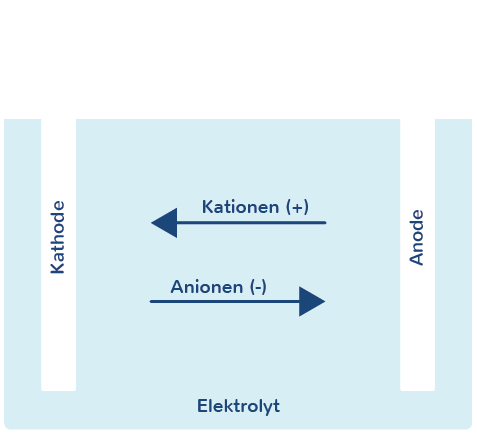
Was ist eine Redoxreaktion?
Eine chemische Reaktion, bei der eine Elektronenübertragung stattfindet, wird als Redoxreaktion bezeichnet. Die Übertragung der Elektronen findet bei der Elektrolyse an den Oberflächen der Elektroden statt und besteht aus zwei Teilreaktionen: Auf der einen Seite werden Elektronen abgegeben und auf der anderen Seite aufgenommen.
Die Abgabe von Elektronen wird als Oxidation bezeichnet, die Aufnahme von Elektronen als Reduktion.
Welche Redoxreaktionen ablaufen, hängt letztlich von der Beschaffenheit des Elektrolyten und dem Material der Elektroden ab.
Did you know?
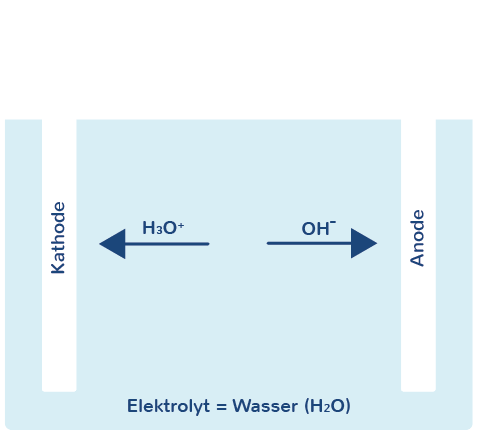
Was passiert bei der Elektrolyse von Wasser?
Die Wasserelektrolyse ist die Zersetzung des Elektrolyts Wasser H2O unter Einwirkung von Strom in Sauerstoff O2 und Wasserstoff H2. Wasser unterliegt einer sg. Autoprotolyse und weist somit eine elektrische Leitfähigkeit auf. Damit ist gemeint, dass Wasser nicht nur in seiner reinen Form als H2O vorliegt, sondern Oxoniumionen (H3O+) und Hydroxidionen (OH-) gebildet werden.
Wird nun Spannung an die Elektroden angelegt, dann wandern die negativ geladenen Hydroxidionen (= Anionen) zur Anode und es bildet sich Sauerstoff O2. Die positiv geladenen Oxoniumionen (= Kationen) wandern zur Kathode und es bildet sich Wasserstoff H2.
Wieso nun die Wasserelektrolyse mit Bor-dotierten Diamantelektroden?
Wird eine Wasserelektrolyse aber mit Bor-dotierten Diamantelektroden durchgeführt, dann werden an der Oberfläche der anodisch geschalteten Diamantelektrode primär OH-Radikale (OH*) gebildet (Quelle: Michaud, 2002).
OH-Radikale zählen zu den stärksten bekannten Oxidationsmitteln und können mit allen anderen am Markt verfügbaren Elektroden nicht bzw. nicht in diesem Ausmaß erzeugt werden (Quelle: Brillas, 2016).
Das Besondere an Oxidationsmitteln ist, dass sie Elektronen aufnehmen und sich dabei selbst reduzieren können.
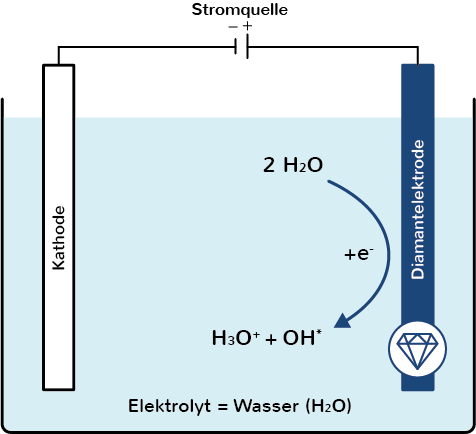
did you know?
OH-Radikale entstehen unter anderem auch in der Atmosphäre aus dem Zusammenwirken von Ozon, Wasser und UV-Strahlen. Sie werden als Waschmittel der Atmosphäre bezeichnet, da sie wesentlich zum Abbau von Luftverunreinigungen beitragen.
mehr Power:
Die Überspannung macht’s möglich!
Die Wasserelektrolyse läuft, laut Theorie, dann ab, wenn die hierfür notwendige Zersetzungsspannung aufgebracht wird. Diese entspricht jener Spannung, die sich aus der Differenz der Elektrodenpotentiale von Anode und Kathode ergibt. Die Praxis zeigt aber, dass die Zersetzungsspannung nicht ausreicht, um die Wasserelektrolyse auszulösen, sondern um die sogenannte Überspannung erhöht sein muss. Die Überspannung ist somit die Differenz aus der tatsächlich gemessenen Spannung (Klemmenspannung) und der berechneten Zersetzungsspannung (Nernst-Gleichung).
Die Überspannung wird unter anderem vom Elektrodenmaterial, der Beschaffenheit der Elektrodenoberfläche, dem Elektrolyt, dem Strom und der Temperatur bestimmt. Die Bor-dotierte Diamantelektrode mit ihrer hohen Überspannung (Quelle: Tröster, 2002; Song 2018) ist bei der Wasserelektrolyse in der Lage, große Mengen an OH-Radikalen zu erzeugen (Quelle: N. Rabaaoui, 2012).
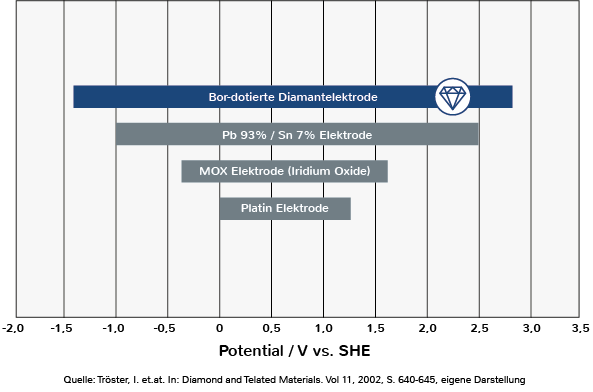
did you know?
Die Bor-dotierte Diamantelektrode ist inert und löst sich daher im elektrochemischen Prozess nicht auf. Zinn- oder Bleielektroden hätten ebenfalls hohe Überspannungen, diese lösen sich aber auf und kontaminieren den Elektrolyten.
INNOVATION UND QUALITÄT:
Die pro aqua Diamantelektrode
Die Kerntechnologie und das Herzstück aller pro aqua Produkte ist die pro aqua Diamantelektrode. Das Trägermaterial der Elektrode ist fluorierter und somit chemikalienbeständiger Kunststoff, der mit Bor-dotierten Diamantpartikeln bestückt ist. Die Bor-Dotierung sorgt für die elektrische Leitfähigkeit der Diamantpartikel, die grundsätzlich keine elektrische Leitfähigkeit aufweisen. Die elektrische Leitfähigkeit ist dafür verantwortlich, dass die besonderen elektrochemischen Eigenschaften der Diamanten in der Elektrolyse überhaupt genutzt werden können.
Die Standardfläche einer pro aqua Diamantelektrode beträgt 700 cm2 (260 x 270 x 0,5 mm). Elektroden über die Standardgröße hinausgehend sind derzeit mit einer Breite von 540 mm begrenzt. In der Länge könnten diese „endlos“ produziert werden. Durch Zuschnitt können aus der Standardelektrode kleinere Elektroden gewonnen werden.
Die pro aqua Diamantelektroden sind langlebig und stabil.
Es können Laufzeiten von mehr als 20.000 Stunden erzielt werden.
Einfache Montage, schnelle Inbetriebnahme
Die pro aqua Diamantelektrode ist flexibel (kann gebogen werden), da das Trägermaterial fluorierter Kunststoff ist. Auch muss die Elektrode bi-polar betrieben werden. Diese technischen Eigenschaften bedingen den sorgfältigen und gekonnten Einbau der Diamantelektroden in eine Durchflusszelle (= elektrochemische Zelle). Die Durchflusszellen verfügen über einen Zu- und Ablauf für den Elektrolyt, zwei elektrische Anschlüsse für die Energieversorgung und entsprechende Vorrichtungen für die Montage. Die Montage und Inbetriebnahme der Durchflusszelle sind somit einfach und schnell möglich.
Der richtige Umgang mit Diamantpartikeln:
Die bi-polare Betriebsweise
Das Trägermaterial (Kunststoff) der pro aqua Diamantelektrode ist elektrisch nichtleitend, daher müssen die Diamantpartikel über eine bi-polare Betriebsweise mit Energie versorgt werden. Hierzu werden eine oder mehrere Diamantelektroden zwischen zwei Kontaktierungselektroden in eine Durchflusszelle eingebaut.
Die Kontaktierungselektroden werden mit Spannung versorgt und der zu behandelnde Elektrolyt (z.B. Wasser) durch die Zelle gepumpt. Die elektrische Leitfähigkeit des Elektrolyten und die spezielle Anordnung der Bor-dotierten Diamantpartikel in der Kunststoffmatrix bewirken, dass der Strom von der Kontaktierungselektrode (Anode) über die Diamanten zur Kontaktierungselektrode (Kathode) fließt.
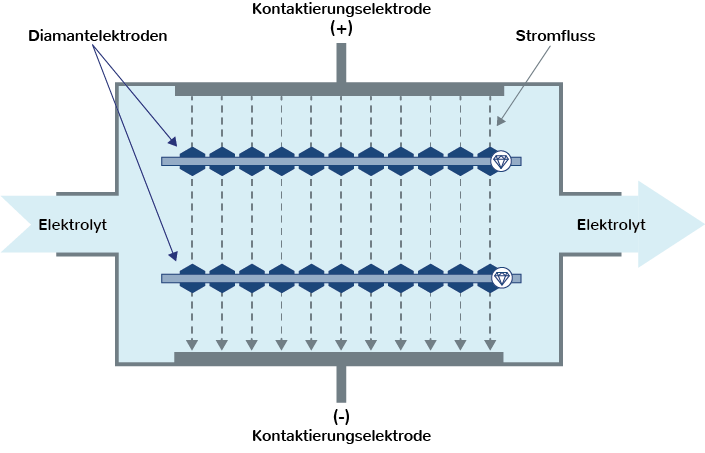
Wasserbehandlung mit der Diamantelektrode:
Eine Technologie, zwei Verfahren
Der Strom aktiviert die Bor-dotierten Diamanten, die dann direkt aus dem Elektrolyt heraus Oxidationsmittel wie OH-Radikale erzeugen. Man spricht dann von elektrochemisch-aktiviertem Wasser, auch Elektrolysewasser. Die im Elektrolysewasser vorhandenen Oxidationsmittel reagieren mit den im (Ab)wasser vorhandenen Schadstoffe (Viren, Bakterien, Organik, etc.) und bauen diese ab.
Die Durchflusszellen können nach dem in-situ oder ex-situ Prinzip betrieben werden.
1. In-situ: Schadstoffabbau direkt in der Zelle
Das in-situ-Prinzip beruht darauf, dass ein verunreinigter Elektrolyt (z.B. Abwasser) durch die Durchflusszelle gepumpt wird. Die durch die Elektrolyse entstehenden Oxidationsmittel wirken direkt in der Durchflusszelle auf die Schadstoffe (z.B. Bakterien oder Organik) und töten/bauen diese ab.
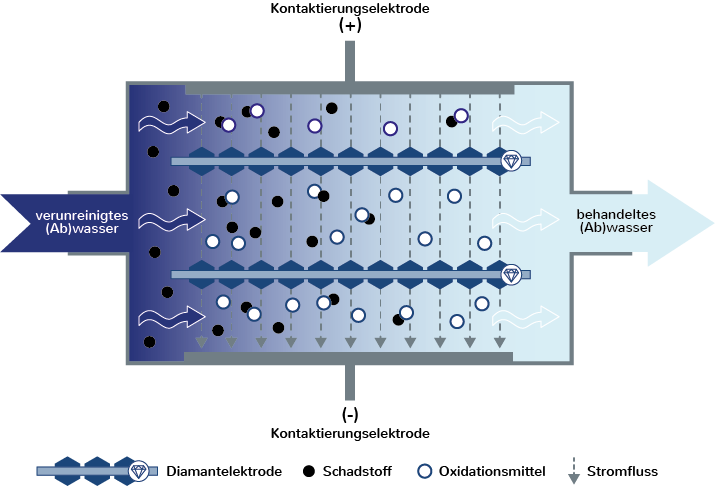
2. Ex-Situ: Schadstoffabbau durch Elektrolysewasser
Das ex-situ-Prinzip beruht darauf, dass ein definierter Elektrolyt (z.B. Wasser) mit einem definierten Salzgehalt durch die Durchflusszelle gepumpt wird. Nach der Elektrolyse liegt ein mit Oxidationsmittel angereichertes Wasser (= Elektrolysewasser) vor, das unter anderem für die Reinigung und Desinfektion von Oberflächen und Anlagen, zum Waschen und Desinfizieren von Obst, Gemüse etc. und den Pflanzen- und Tierschutz eingesetzt wird.
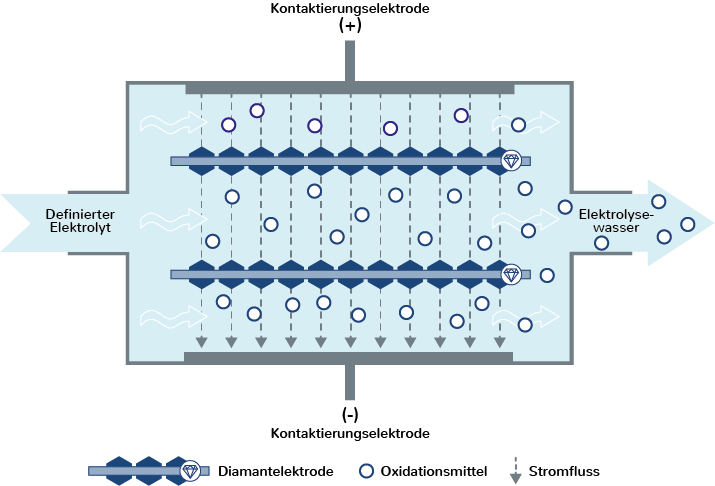
Sie haben Interesse an unseren Produkten oder einer Kooperation?
